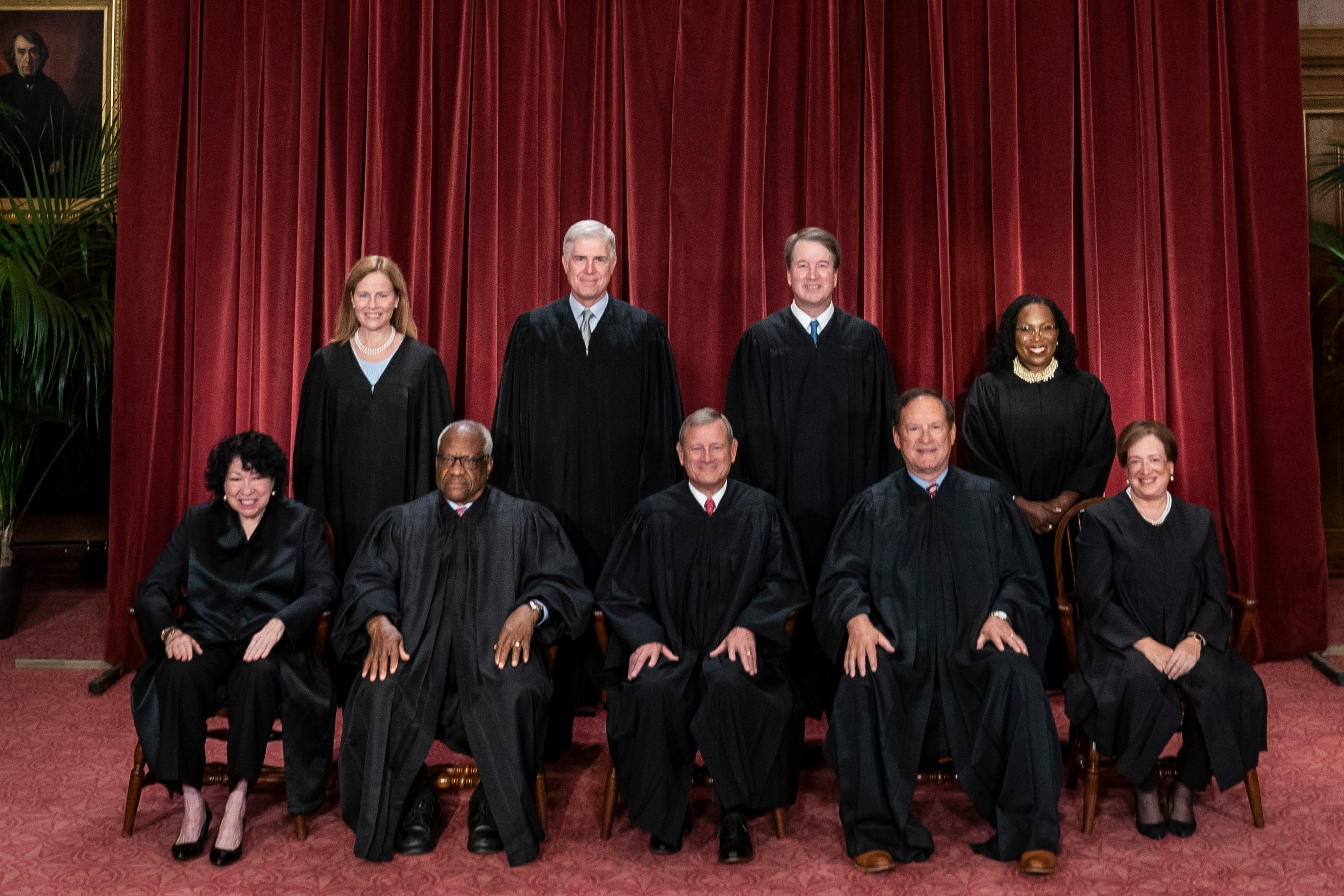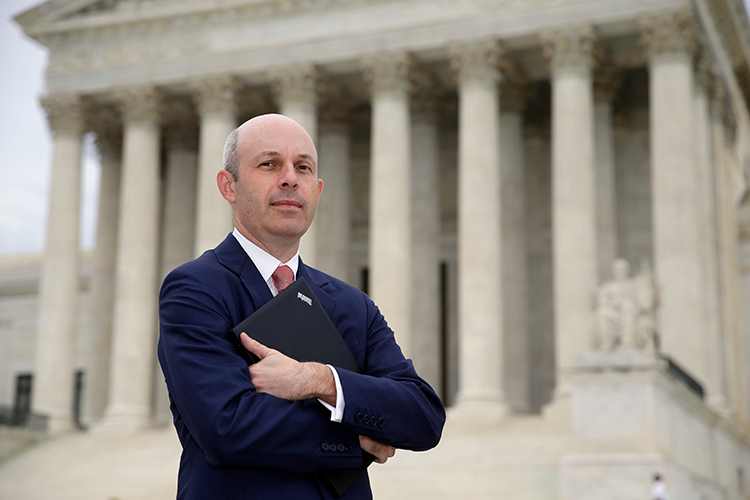Supreme Court justices are writing more concurrent opinions to accompany rulings

Members of the Supreme Court sit for a group photo in 2022. Some legal observers believe, only partly in jest, that the court is slowly inching back to its seriatim days. The justices seem to be writing a lot of concurrences. (Jabin Botsford/The Washington Post)
Just before the U.S. Supreme Court’s 2023-2024 term began last fall, Justice Amy Coney Barrett appeared before a law school audience for a generally esoteric, theory-laden discussion of her approach to the court.
The conversation at Catholic University of America in Washington between Barrett and Kevin C. Walsh, a law professor there, eventually turned to the topic of concurring opinions. Barrett, who has written some noteworthy concurrences in her nearly four full terms on the court, gave an outline of her approach to writing separately from the majority opinion.
Barrett said she may write on her own “if I have something that I really think that I need to add that will help the development of the law or if there is an explanation that I feel that I owe.”
The former law professor at the University of Notre Dame who still dabbles in law teaching then gave the assembled law students and others in the audience a quick lesson in Supreme Court history.
“The court, in its early days—justices wrote seriatim opinions, which meant that there was no opinion for the court, but each justice individually wrote an opinion setting forth his—they were all men then—own reasoning,” Barrett said at the Sept. 21 event. “Chief Justice John Marshall is the one who instituted the practice of having an opinion for the court.”
Some legal observers believe, only partly in jest, that the court is slowly inching back to its seriatim days. The justices seem to be writing a lot of concurrences.
“They are concurring more often,” says Adam Feldman, the founder of Empirical SCOTUS, a website that offers statistical data and analysis of the court. “We see that in the numbers.”
Feldman compiled figures going back several decades about the average number of concurring votes per majority opinion. (Concurring votes include the justice who wrote the concurring opinion and anyone who joined it.) In the 1955-56 term, that figure was a low of .30. From 1946 through the end of the 2022-23 term, the average was .80.
For the just-concluded 2023-2024 term, the figure was and average of 1.44 concurring votes per majority opinion, a shade above the previous term’s figure of 1.23.
“The justices are more confident about their own policy positions, so even if they agree with the majority’s outlook, they want to be able to say things in their own words,” says Feldman, who is also a lecturer in political science at California State University, Northridge.
‘A very fractured body’
Meg Penrose, a professor at Texas A&M University’s law school in Fort Worth, wrote a 2023 article in the George Mason Law Review titled, “Legal Clutter: How Concurring Opinions Create Unnecessary Confusion and Encourage Litigation.”
“The Roberts Court has become a court filled with individual opinion writers,” she wrote, referring to Chief Justice John Roberts. She suggested that the court had already essentially “returned to the era of seriatim opinions. Every justice appears willing to speak solely for themselves.”
Penrose says in an interview that the members of the court did not seem to read her article going into this past term, or if they did, it had no apparent effect on their propensity to write concurrences.
She notices many “lone wolf concurrences” that suggest “a very fractured body.”
Take United States v. Rahimi, several observers said. The June 21 decision that upheld a federal statute allowing individuals subject to a domestic violence restraining order to be disarmed was decided 8-1. Justice Clarence Thomas was the lone dissenter. Seven justices joined the chief justice’s majority opinion in full, but six of those justices wrote or joined five separate concurrences.
Justice Brett M. Kavanaugh wrote a 24-page concurrence that exceeded the length of the 18-page majority opinion in a case that drew attention for its perceived scaling back of the court’s landmark 2022 decision that set a new history and tradition test for evaluating gun restrictions under the Second Amendment.
“I add this concurring opinion to review the roles of text, history, and precedent in constitutional interpretation,” Kavanaugh wrote.
Gregory G. Garre, a former U.S. solicitor general under President George W. Bush and now a partner at Latham & Watkins in Washington, D.C., says the number of separate concurrences in cases such as Rahimi underscore that the justices, particularly among the court’s conservative bloc, “have starkly different views on how to approach cases.”
“The fact that so many of the justices are writing separately at length to stress their own views … indicates that the six conservative justices are not necessarily in sync on all these issues,” Garre says.
All the concurrences are getting to be a bit too much, Garre says: “From the standpoint of resolving what a rule of law should be, fewer opinions is more.”
A concurrence suggesting turning down the national temperature
Justices Thomas and Neil Gorsuch have led the pack with the most concurrences in recent terms, according to Feldman’s statistics, followed by Kavanaugh and Samuel Alito. The chief justice has written or joined the fewest concurrences in recent terms.
“Kavanaugh has three-plus as many concurring votes as Roberts,” Feldman says. “Roberts is usually with the majority, and he likes to lead in that vein.”
Concurring opinions aren’t new, of course, as justices have often written them to explain some measure of disagreement with a majority opinion they have signed onto in whole or in part. Some concurrences are written to respond to a dissent if the author thinks the majority opinion has inadequately done so. And yet others lay down markers suggesting a court precedent is ripe for overruling.
Thomas, for example, used to do that with his dissents, but now it is just as likely to be a concurrence where “he is always talking about the next case” he would like to see, Feldman says.
Barrett has been largely in the middle of the pack in terms of frequency of concurring opinions. This past term, however, she wrote a few that got a fair amount of attention.
In March, in Trump v. Anderson, the court ruled unanimously that Colorado was wrong to exclude former President Donald Trump from the 2024 primary ballot because the Constitution makes Congress, not the states, responsible for enforcing against federal officeholders the 14th Amendment’s prohibition against service by those who engaged in “insurrection or rebellion.”
In a brief concurrence for herself, Barrett seemed to take aim at an opinion concurring in the judgment, signed jointly by the court’s liberal bloc of Justices Sonia Sotomayor, Elena Kagan and Ketanji Brown Jackson, that disagreed with the scope of the unsigned majority opinion. (Their opinion read more like a dissent to many observers.)
“In my judgment, this is not the time to amplify disagreement with stridency,” wrote Barrett, who was appointed to the court by Trump. “The court has settled a politically charged issue in the volatile season of a presidential election. Particularly in this circumstance, writings on the court should turn the national temperature down, not up.”
In June, in Trump v. United States, Barrett joined most of the 6-3 opinion by Roberts holding that a former president has absolute immunity from criminal prosecution for his acts under his “conclusive” constitutional authority and presumptive immunity for his other official acts. But she wrote an opinion concurring in part that outlined a less robust view of immunity for official acts, including that she disagreed with the majority opinion’s view that protected conduct could not be admitted as evidence in a criminal prosecution of a former president.
“On this score, I agree with the dissent,” Barrett said. “The Constitution does not require blinding juries to the circumstances surrounding conduct for which presidents can be held liable.”
At Catholic University last September, Barrett could not have known that the term about to start would see two major cases come before the court involving the former president, cases in which she would feel the need to write separately.
She emphasized the importance of the majority opinion speaking for the court but said there were just times when she felt the need to explain herself.
“I will also write if I feel it would be valuable to lower courts to understand the limits of [a majority] opinion or what an opinion is doing,” she said. “Everybody has their own philosophy. Personally, if I ask myself the question, is this the function of the seriatim opinion where I just feel like I need to say my piece, I would not be inclined to do it.”
Noting that she was still relatively new to the court, she added a caveat: “Surely my views may well change over time.”



